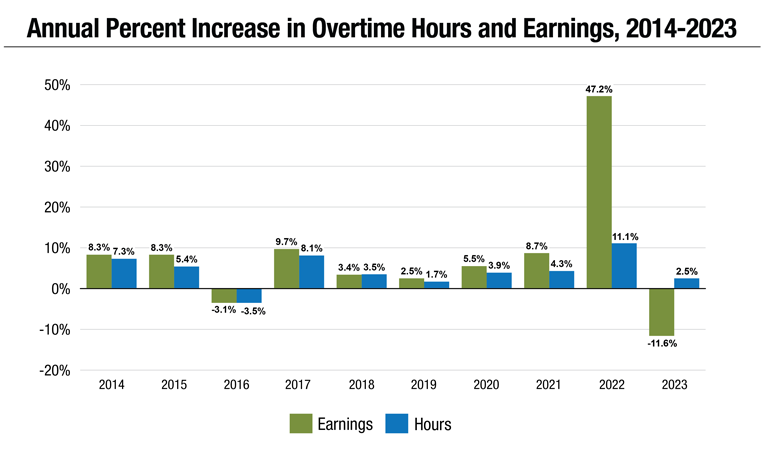New York State agency overtime costs in 2023 were $1.2 billion, down 11.6% from 2022, marking the first decrease in total overtime earnings since 2016, according to a report by State Comptroller Thomas P. DiNapoli.
The decrease was led by declines in overtime hours at three of the five agencies that are historically the largest overtime users. This drop in overtime earnings also corresponded with declining responsibilities for emergency response to the COVID-19 pandemic and an overall increase in the size of the state workforce for the first time since 2019, growing by 2.5% in 2023.
“State agencies should ensure that overtime use is justified, and services are provided safely and effectively,” DiNapoli said. “New York state’s workforce helped us get through the toughest times during the pandemic and the state needs to continue its efforts to attract and retain a range of diverse employees, especially in the context of a competitive job market.”
Key Findings:
- Three large agencies accounted for about two-thirds of the state’s overtime hours in 2023. The Department of Corrections and Community Supervision (Corrections), the Office for People with Developmental Disabilities (OPWDD), and the Office of Mental Health (Mental Health) comprised 23.6% of the workforce but accounted for 68.7% of the overtime hours. A 16.4% (almost 870,000 hours) rise in overtime hours at Corrections was a large driver in the 2.5% total growth in total state agency overtime hours in 2023.
- There were significant decreases in overtime hours in 2023 at the Department of Labor (74%) and the Department of Health (38.1%), which both had primary responsibilities for relief during the pandemic, and a drop in related earnings at OPWDD (27.5%, $101 million), Mental Health (27.8%, $68.5 million) and the State University of New York (SUNY, 31.2%, $44.1 million) contributed the most to the total overtime earnings decrease in 2023.
- More than 66% of overtime earnings in 2023 were concentrated at three agencies that manage institutional settings: Corrections, OPWDD, and Mental Health, with overtime earnings in 2023 of $353 million, $266.7 million, and $177.5 million, respectively.
In 2023, total state payroll costs were $19.3 billion, with overtime totaling $1.2 billion. Overtime earnings as a share of total payroll grew from 4.3% in 2014 to 6.2% in 2023, as total overtime hours increased over this period by 6.78 million hours, or 42.6%. Pay rates also increased during this time, contributing to a growth of almost 82% in overtime earnings, from $661 million in 2014 to $1.2 billion in 2023, or a 7.8% average annual increase. In 2023, overtime as a share of payroll was at its second highest rate since 2007.
Corrections represented close to 6.2 million hours, or over 27% of all state agency overtime hours; OPWDD more than 6 million hours, 26.6%; and Mental Health nearly 3.4 million hours, or almost 15%.
State Workforce Trends
During the 10-year period analyzed by this report, the average annual number of employees working for the state, not including SUNY and City University of New York (CUNY), declined from 156,752 employees in 2014 to 142,396 in 2022. In 2023, the workforce increased for the first time since 2019, up 3,583 positions from the previous year, to almost 146,000.
This aggregate growth in the state workforce reflects actions taken by the state in the last two fiscal years to rebuild its workforce. Overall, the reduction in overtime earnings has coincided with this shift. Data from 2022 further indicate that attrition has slowed while new hiring has increased; however, attrition continued to outpace new hiring.
In 2022, 16,211 people left the state workforce. As job opportunities increased with the recovery from the pandemic, the number of employees leaving for reasons other than retirement grew significantly in 2021 and 2022, presenting a challenge for recruiting and retaining employees.
Report
New York State Agency Use of Overtime and State Workforce Trends, 2014-2023


